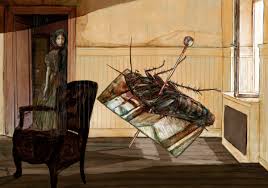
Franz Kafka's 'The Metamorphosis' and The Process of Identity
“[I]dentities are never completed, never finished; [...] they are always subjectively itself is, in process”.
Franz Kafka’s The Metamorphosis can be interpreted on various levels, and has provoked discussion about alienation, capitalism, ideology and abjection of Jewish identity. However, I am primarily offering a more theoretical analysis regarding identity in terms of its cultural and social importance. The concept of personal identity pervades Kafka’s novella as one of the most prominent topics, portrayed as incomprehensible, deliberately ambiguous and challenging to navigate. Kafka, a man struggling with his own identity, balances simultaneous ideas of realism and fantasy: normality and abnormality. The novella sets a foundation for defining identity and its societal influences, provoking later philosophical and existential debate about whether, and if so how, identity can be fully defined.
Throughout The Metamorphosis, Kafka offers a clear depiction of identity as obscure and indeterminate; a “process” (Hall, pp. 41-68). When examining this text, it is important to consider the act of translation from the original Der Verwandlung to The Metamorphosis. In the original text, Kafka describes Gregor as “einem ungeheuren Ungeziefer” (Kafka, 75), an ambiguous phrase which cannot be accurately translated into English. Kafka’s first description of Gregor Samsa’s physical state includes the prefix ‘un’, a negation which can only be used for negative meaning. All that is revealed is that Gregor’s identity has completely transformed and that it can only be negative. Translators struggle to specify which species Gregor actually is supposed to exist as. Some translations describe him as a “horrible vermin” (Kafka, Project Gutenberg), while others describe him as “monstrous cockroach” (Kafka, Penguin Classics, 75) and a “bug” (Planet) - all presenting themselves with slightly different connotations. In both English and German versions of this text, it is hard to decipher what Gregor exists as and whether he could be his previous ‘self’. Additionally, the German noun “Ungeziefer” is neutral, thus Gregor’s identity, not only as a ‘human’ but a man, begins to fluctuate. It is no doubt therefore that Kafka has done this deliberately; avoiding a banal description of Gregor’s ‘monstrosity’, suggesting that identity is an indefinable and vague concept, even without translation. It is widely known that Kafka himself held strong obligations against any editors sketching Gregor’s character. This amplifies that identity cannot be represented or solidified into one single image, but can be interpreted and discussed as a wider concept. Quite an interesting textual example of this is the pronoun shift used to describe Gregor, in particular through the dialogue between his family members. Kafka switches between the initial use of “he” (85) to an “it” in various instances, as clarified by Gregor’s sister Grete that they “must try and get rid of it [...] otherwise it’ll be the death of [them] (119). Gregor’s character is less valued as he decreases in size, both literally and metaphorically, hinting that what makes us ‘human’ and identifiable is to be understood by those who “tolerate” us (94).
The “never finished” (Hart) construction of identity is seen through Gregor’s declining transformation alongside alternative transformations as well. The Metamorphosis as a title is ambiguous itself, never clarifying which, or whose, metamorphosis this is. However, I offer the argument that the most overt transformation is that of identity. Kafka opens up the novella with Gregor’s transformation of identity, and ends with a bizarre and even optimistic transformation of Grete’s blossoming identity. Her character serves as a clear image of an alternative self for Gregor, hinting at an element of exchange in the changing of identity. Grete has “bloomed into an attractive and well-built girl” who will soon “find a suitable husband” (126), transformed into a new identity at Gregor’s expense. Kafka deliberately uses ambiguity to demonstrate that identity is not an objective thing but a matter of interpretation.
Alternatively, the contingency of identity and its development is highlighted through Kafka’s craft of Gregory’s family. In this case, Gregor’s identity and sense of self is maintained and even manipulated by assumptions and regulations from the family. Mrs Samsa’s “face [being] irretrievably sunk against her bosom” (86) suggests that this transformation automatically means that Gregor would look monstrous; Greta feeds Gregor “cheese [...] declared unfit for human consumption” (94) under the expectation that he is animal-like and has certain “likes and dislikes” (94). Gregor’s irreversible change into an insect places him into a ‘label’ where he is kept. The Metamorphosis is an obvious example of the term “Kafkaesque”; critics have been open to discussing the obvious hints of his own troubled family experiences: writing in a letter, Kafka stated that
“[families] deprive their children, step by step, of the right to their own personality” (Letter to Elli Herrman, 1921).
Kafka aligns Gregor’s position with the “paradoxical” definition of ideology presented by French philosopher Louis Althusser, that “ideology interpellates individuals into subjects” (Althusser). As “individuals”, Althusser implies that people can freely and uniquely be themselves, whereas power and external forces transform us into “subjects”. This form of identification becomes more dehumanised and detached; it hints at privilege and value, rather than individuality and independence. It is also interesting to note that Gregor regains the pronoun “he” after his death as “he stopped eating such a long time ago” (Kafka, 123). Althusser’s definition of ideology helps us to understand how Kafka represents the relationship between identity and ideology. Who, or what, Gregor was is a constantly changing concept, and is adopted by society’s responses - opening the novella up for a dualist or social-constructionist reading: Gregor loses all of his previous identity and ceases to exist. To an extent, Gregor is reconnected to his previous identity on a very basic level, indicating an element of fluidity in terms of identity.
The most salient part of the text to consider when examining this is Gregor’s death, opening up the novella to a social-constructionist debate - Gregor’s position as a breadwinner in a capitalist society has been dissolved and his death comes as a result of a lack of purpose. Gregor is deemed no longer useful and (what is left of) his identity is to be “pushed [...] across the floor” by the chairwoman’s broom (123) and quickly disposed of. As Sweeney states,
“instead of just making one point and sticking to one consistent theoretical framework, Kafka offers lots of different ideas that seem to be in conversation with one another” (Sweeney, pp. 23-35).
Whilst the concept of identity is still challenging to fully define, Kafka’s The Metamorphosis provides a “radical starting point” (Said, 49) to its wider philosophical debate. Gregor’s loss of identity is not about finality but transformation, and Kafka’s novella provides a prime example of Hall’s claim of the increasing “process” of identity.
References:
Althusser, Louis. “Ideology and Ideological State Apparatuses.” Lenin and Philosophy and Other Essays, Monthly Review Press 1971, Trans. by Ben Brewster, 1970, https://www.marxists.org/reference/archive/althusser/1970/ideology.htm.
Kafka, Franz. Metamorphosis and Other Stories: Penguin Classics. National Geographic Books. 2019.
Kafka, Franz. “The Metamorphosis - Planet EBook”. The Metamorphosis by Franz Kafka, Trans. Ian Johnston, Jan. 1999, https://www.pdfdrive.com/the-metamorphosis-planet-ebook- e3649741.html.
Kafka, Franz. “The Metamorphosis.” The Project Gutenberg EBook of Metamorphosis, by Franz Kafka, Trans. David Wyllie, 13 May 2002, https://www.gutenberg.org/files/5200/5200-h/5200-h.htm.
Said, Edward. “Beginnings”, Salmagundi, 1968.
Sweeney, Kevin. “Competing Theories of Identity in Kafka’s The Metamorphosis”. Mosaic 23.4, 1990.


